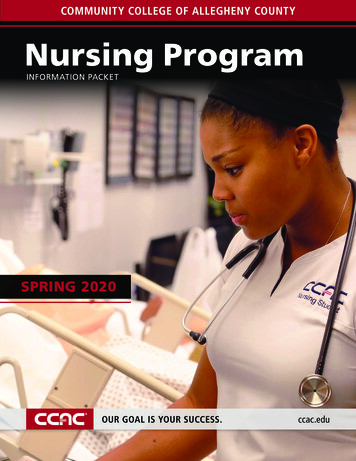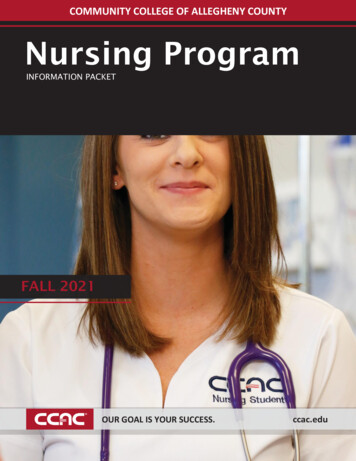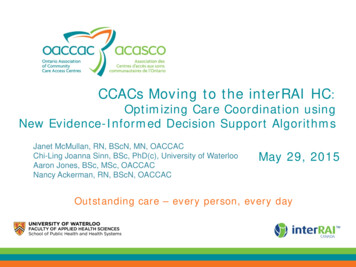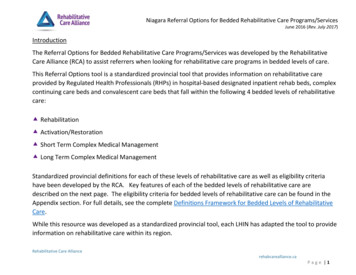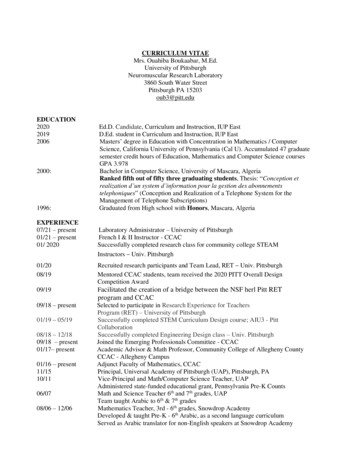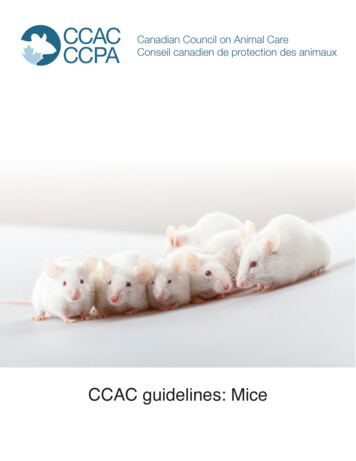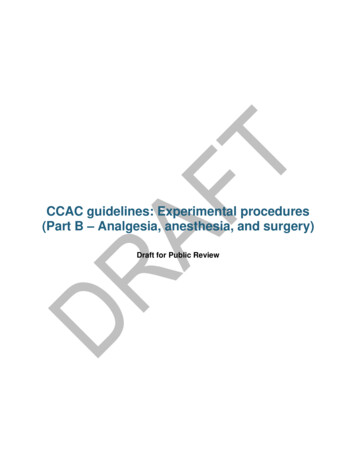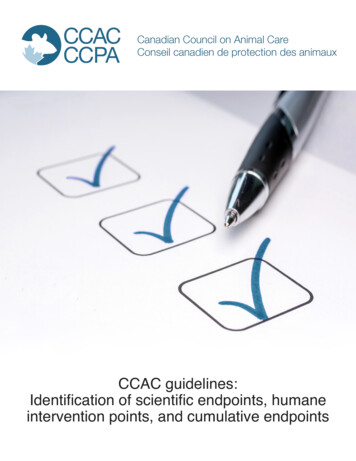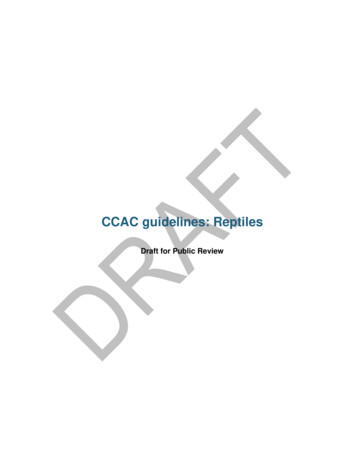
Transcription
CCAC guidelines: ReptilesDraft for Public Review
CCAC guidelines: ReptilesDraft for Public Review – March 2022TABLE OF CONTENTSPREFACE.1LIST OF GUIDELINES .21.INTRODUCTION .61.1Behavioural Biology .71.1.1 Thermoregulatory Behaviour .81.1.2 Social Interactions .81.2Anatomy and Physiology.81.3Senses.91.4Sources of Variation.91.4.1 Strain .101.4.2 Developmental Stage .101.4.3 Individual Differences – Sex, Health Status, Social Status, andBehavioural Preferences .101.4.4 Effects of the Environment and Previous Experience .112.FACILITIES .122.1Animal Rooms and Procedure Rooms .122.2Enclosures .132.2.1 Spatial Requirements .142.2.2 Enclosure Design .142.2.3 Terrestrial Holding Systems .152.2.4 Aquatic Holding Systems.173.FACILITY MANAGEMENT AND PERSONNEL .193.1Managing the Environment .193.1.1 Lighting .193.1.2 Temperature and Relative Humidity .203.1.3 Air and Water Quality .223.1.4 Sound and Vibration .233.1.5 Brumation Requirements .233.2Personnel .243.3Pest and Vermin Control .244.PROCUREMENT.254.1Source .254.1.1 Captive Bred .254.1.2 Wild Caught .264.2Regulations .274.3Pre-Shipment Procedures .284.4Transportation.284.5Receiving Animals .294.6Quarantine and Acclimation .30i
CCAC guidelines: ReptilesDraft for Public Review – March 20225.BREEDING.315.1Rationale (When and Why Internal Breeding Programs are Indicatedor Acceptable).315.2Specialized Facility Needs (Incubation, Nursery, and Specialized FoodMaintenance Requirements) .325.3Physiological Considerations .325.3.1 Sexual Maturity .325.3.2 Reptile Reproductive Strategies .335.3.3 Reproductive Cycles .335.3.4 Physiological and Environmental Stimulus .335.3.5 Pairing and Mating .345.4Breeding and Mating Conditions .345.4.1 Artificial Induction of Breeding .345.5Gestation Monitoring .345.6Incubation of Eggs and Nursery Activities .355.7Care of Offspring .376.HUSBANDRY .396.1Identification.396.2Animal Observation.396.3Housing Management .396.4Feeding and Nutrition.406.4.1 Food .406.4.2 Drinking Water .466.5Substrates and Furnishings .476.5.1 Terrestrial Environments .476.5.2 Arboreal Environments .486.5.3 Aquatic Environments .486.6Environmental Enrichment .496.6.1 Predatory Behaviour.506.6.2 Furnishings – Resting Spots, Platforms, Behavioural Thermoregulation,Areas to Retreat .516.6.3 Social Interactions .516.6.4 Digging .526.7Human Contact and Handling .526.8Animal Monitoring .536.9Cleaning and Sanitation .536.10 Record Keeping .547.HANDLING AND RESTRAINT .557.1Physical Handling and Restraint .557.1.1 Free Handling.567.1.2 Handling and Restraint Devices .567.1.3 Safety.587.2Chemical Restraint.59ii
CCAC guidelines: ReptilesDraft for Public Review – March 20228.HEALTH AND DISEASE CONTROL .618.1Disease Prevention .618.2Health Monitoring and Disease Detection .628.2.1 Common Diseases and Conditions .638.3Disease Management in the Event of an Infectious Outbreak .659.WELFARE ASSESSMENT .669.1Welfare Indicators .6710. EXPERIMENTAL PROCEDURES .6910.1 Animal Models .7010.2 Administration of Substances.7110.2.1 Lizards .7210.2.2 Snakes .7310.2.3 Turtles .7310.2.4 Crocodiles .7410.3 Collection of Body Fluids or Tissue .7410.3.1 Blood Collection .7410.3.2 Urine and Feces .7710.3.3 Tissue Biopsy .7710.4 Implants .7710.5 Procedures for Genetically Modified Reptiles .7710.5.1 Collecting Samples for Genotyping .7810.5.2 Phenotyping .7810.6 Imaging .7910.7 Behavioural Studies .7910.8 Food and Fluid Intake Regulation .7910.9 Anesthesia and Analgesia.8010.9.1 Anesthesia .8010.9.2 Analgesia and Anti-Nociception .8210.10 Surgery .8210.11 Monitoring and Post-Procedural Care .8311. EUTHANASIA .8411.1 Injection .8411.2 Inhalant Anesthetics.8511.3 Physical Methods .8511.4 Freezing.8511.5 Euthanasia of Eggs .8611.6 Verification of Death.8612. END OF STUDY .8712.1 Transfer of Reptiles Between Facilities or Protocols .8712.2 Rehoming .8712.3 Release to the Wild .8712.4 Disposal of Dead Reptiles .87iii
CCAC guidelines: ReptilesDraft for Public Review – March 202213. HUMAN SAFETY .8813.1 Working With Venomous Reptiles .88REFERENCES .90APPENDIX 1 LIST OF USEFUL RESOURCES .107APPENDIX 2 BASIC INFORMATION ON REPTILES COMMONLY HELD INCANADIAN LABORATORIES .108iv
CCAC guidelines: ReptilesDraft for Public Review – March 20221PREFACE234The Canadian Council on Animal Care (CCAC) is the national peer-review organizationresponsible for setting, maintaining, and overseeing the implementation of high standards ofethical care and use of animals in science throughout Canada.5678910The CCAC guidelines: Reptiles provides information for investigators, study directors, instructors,animal care committees, facility managers, veterinarians, and animal care personnel to helpfacilitate improvement in both the care given to reptiles and how experimental procedures arecarried out. These guidelines address conditions normally present in laboratories housing reptiles;where experimental conditions required by studies differ from the guidelines, they must bejustified to, and approved by, the animal care committee.1112The individual guideline statements in the document have been developed based on expert peeradvice and current interpretation of scientific evidence.13141516CCAC guidelines are intended to provide a framework for implementing Russell and Burch’sThree Rs: Replacement, Reduction, and Refinement (Russell and Burch, 1959), primarily theprinciple of Refinement. These practices are constantly evolving, and refinements should result incontinual improvement in animal welfare.171819For studies outside of Canada, investigators based at CCAC-certified institutions are subject tothese guidelines and the relevant legislation and regulations pertaining to ethical animal care anduse in the country where the study is conducted.1
CCAC guidelines: ReptilesDraft for Public Review – March 202220LIST OF GUIDELINES212223242526The following list of guideline statements serves as an executive summary covering the mostimportant aspects of the care and use of reptiles. These guideline statements are includedthroughout this document alongside details and references that provide support and context fortheir implementation. Throughout this document, the term ‘should’ is used to indicate anobligation, for which any exceptions must be justified to, and approved by, an animal carecommittee. The term ‘must’ is used for mandatory requirements.272. Facilities28293031Guideline 1Enclosures must provide sufficient space and complexity to enable reptiles to perform behavioursimportant to their welfare.Section 2.2 Enclosures32333435Guideline 2Regardless of what type of terrestrial cage is chosen, it must be possible to control theenvironmental conditions within it to meet the needs of the species to be housed.Section 2.2.3 Terrestrial Holding Systems363. Facility Management and Personnel3738394041Guideline 3Laboratory management practices must aim to ensure the macroenvironment (room) andmicroenvironment (primary enclosure) maintain the health and welfare of both the animals andpersonnel and provide consistency for research outcomes.Section 3.1 Managing the Environment424344Guideline 4Water quality must be monitored.Section 3.1.3.2 Water Quality454647Guideline 5Reptiles must be observed regularly by trained personnel, with minimal disruption to the animals.Section 3.2 Personnel484. Procurement4950515253Guideline 6Facilities and investigators acquiring or transporting reptiles, or conducting research on reptiles,must be familiar with and comply with relevant international, federal, and provincial or territoriallegislation and policies.Section 4.1 Source2
CCAC guidelines: ReptilesDraft for Public Review – March 202254555657Guideline 7Information relating to the transport, welfare, and care of the reptiles should be communicatedbetween the supplier and receiver before shipment of the reptiles occurs.Section 4.3 Pre-Shipment Procedures585960Guideline 8The health status of reptiles being received should be reviewed before animals are shipped.Section 4.4 Transportation61626364Guideline 9Animals should not be shipped if weather forecasts predict extreme (very hot or very cold)temperatures.Section 4.4 Transportation65666768Guideline 10The health and welfare of reptiles must be checked upon their arrival by competent animal carepersonnel.Section 4.5 Receiving Animals69707172Guideline 11Reptiles should undergo quarantine and acclimation after transport and before use in a scientificactivity.Section 4.6 Quarantine and Acclimation735. Breeding74757677Guideline 12Species-specific health assessment benchmarks should be established for breeding animals, andthese should be met before initiating breeding.Section 5.3 Physiological Considerations786. Husbandry798081Guideline 13Environmental enrichment relevant to the species and life stage should be provided.Section 6.6 Environmental Enrichment827. Handling and Restraint83848586Guideline 14Reptiles should only be handled when necessary, according to the purpose, and the handling timeshould be minimized.Section 7.1 Physical Handling and Restraint3
CCAC guidelines: ReptilesDraft for Public Review – March 202287888990Guideline 15Reptiles must be continually monitored during anesthesia, with particular attention paid torespiration, heart rate, and depth of anesthesia.Section 7.2 Chemical Restraint918. Health and Disease Control929394Guideline 16All reptiles should be included in an animal health program, irrespective of where they are housed.Section 8 Health and Disease Control95969798Guideline 17Strategic measures for disease prevention should include a plan for disease control and a systemof regular monitoring and reporting for health assessment purposes.Section 8.1 Disease Prevention99100101102103Guideline 18SOPs should be developed for assessing animal health, providing health care, and treating commonhealth problems for the animals; these should be reassessed at least every three years to ensurerelevance.Section 8.2 Health Monitoring and Disease Detection104105106Guideline 19A response plan must be in place to deal with potential disease outbreaks.Section 8.3 Disease Management in the Event of an Infectious Outbreak1079. Welfare Assessment108109110Guideline 20All reptiles maintained in an animal facility must be subject to routine welfare assessments.Section 9 Welfare Assessment11110. Experimental Procedures112113114115Guideline 21:The least invasive method suited to the goals of the study must be used, with consideration of thepotential impacts of the procedures on the reptiles and measures taken to reduce those impacts.Section 10 Experimental Procedures116117118119Guideline 22:Endpoints must be developed and must be approved by the animal care committee before thecommencement of the study to minimize the negative impacts of procedures on the animal.Section 10 Experimental Procedures4
CCAC guidelines: ReptilesDraft for Public Review – March 202212011. Euthanasia121Guideline 23:122123Euthanasia of reptiles must only be carried out by competent personnel using an approved methodbest suited to the particular species and life stage and to the study objectives.124Section 11 Euthanasia5
CCAC guidelines: ReptilesDraft for Public Review – March 20221.125INTRODUCTION126127128Throughout this document, the term ‘should’ is used to indicate an obligation, for which anyexceptions must be justified to, and approved by, an animal care committee. The term ‘must’is used for mandatory eptiles are a diverse group, with approximately 10,850 known species and new species beingdescribed regularly. Reptiles include Squamata – lizards, snakes, and amphisbaenians or “wormlizards” (approximately 10,500 species); Chelonia – turtles and tortoises (approximately 350species); Crocodilia – crocodiles, gharials, caimans, and alligators (24 species); and Sphenodontiatuataras from New Zealand (1 species). From a practical perspective, non-avian reptiles (hereafter“reptiles”) are best considered as a distinct group of ectothermic (cold-blooded), air-breathingvertebrates that employ internal fertilization and amniotic development. They have keratinizedscales covering part or all of their body. Reptiles display a wide range of physiological andbehavioural adaptations to specific environmental conditions. Therefore, it is critical to be awareof the animal’s individual needs and how their housing environment and any studies they areinvolved in influence their welfare. These guidelines apply to a diverse classification of species,and therefore species-specific expertise is often required for correct interpretation.141142143144145146The CCAC guidelines: Reptiles focuses on reptiles housed in laboratory facilities. For studiesinvolving reptiles in the wild, including short-term holding in the field, see the CCAC guidelineson: the care and use of wildlife (2003). Most reptiles lay eggs, although some bear their younglive. Currently, the developing eggs of oviparous reptiles (who produce young by means of eggsthat hatch after having been laid by the parent) are not covered by this guidelines document, as theCCAC does not require an animal use protocol for these life stages.147148149150151152Canadian facilities house a wide range of reptile species, the most reported of which are beardeddragons, leopard geckos, crested geckos, anoles, terrapins, box turtles, garter snakes, gophersnakes, ball pythons, corn snakes and boa constrictors. Reptiles (both captive-bred and wildcaught) contribute to a wide range of studies in regeneration, comparative anatomy, comparativephysiology, nutrition, diagnostic imaging, ecology, aggression, stress physiology, reproductivecycles, and the effects of neurotoxins (Crawford et al., 2001).153Some of the challenges associated with reptile-based studies include:154155156157158159160161162163164 species-specific housing and care requirements at different life stages;limited knowledge of reptile husbandry and welfare for many species;limitations in the recognition, evaluation, and alleviation of nociception, discomfort, anddistress;challenges associated with distinct anatomy (e.g., suturing of skin) for studies involvingsurgical procedures;an inherent difficulty in maintaining asepsis for surgery and recovery in aquatic species;potential adverse effects on animal welfare when used as disease models;lack of veterinary support and knowledge;lack of a consistent genetic background; andprocurement in general, and a lack of captive-bred, pathogen-free sources in particular.6
CCAC guidelines: ReptilesDraft for Public Review – March 2022165166167168169170171Those working with a species must have a comprehensive understanding of the animals’ housingand husbandry requirements, which can be acquired through literature searches and consultationwith investigators, veterinarians, and others having experience with that species. Whereknowledge of a species’ optimal conditions is lacking, these guidelines and the species’ naturalhabitat provide an appropriate starting point, which should be followed up with careful monitoringand adjustment. Facility-specific standard operating procedures (SOPs) must be developed for thehusbandry of each species.172173174As with any animal-based science, the scientific validity of any protocol involving reptiles mustbe established carefully, and the Three Rs (Replacement, Reduction, and Refinement) (Russell andBurch, 1959) must guide decisions concerning experimental design and the care of the animals.175176177178179Replacement is an important consideration in planning any animal-based study. Considerationmust also be given to Reduction, to determine the fewest number of animals appropriate to providereproducible valid information and statistical power while minimizing the welfare impact for eachanimal. Sample size calculations must be carried out, and a biostatistician should be consultedwhen necessary.180181182183184The present guidelines focus primarily on Refinement, both in terms of the care of reptiles in afacility and procedures carried out on reptiles as part of an animal-based protocol approved by ananimal care committee. Animals living in an environment where facilities and practices areoriented toward promoting good animal welfare are less likely to be stressed and more likely toexhibit normal behaviours and physiology (Poole, 1997).185186187188189190191192193The following sections provide a brief overview of the behavioural biology important to thewelfare of reptiles (Section 1.1, “Behavioural Biology”), the anatomical and physiologicalcharacteristics of reptiles (Section 1.2, “Anatomy and Physiology”), the sensory abilities of reptiles(Section 1.3, “Senses”), and potential inter-animal variations (Section 1.4, “Sources of Variation”).This information forms the basis of this document and has an impact on welfare considerations. Itis important to consider the characteristics of the species (and strain where applicable), sex, lifestage (age, breeding status, season), and prandial status (i.e., when the animal was last fed) as wellas the specific characteristics of the individuals when considering the impact of a procedure orcondition on the welfare of reptiles and on the research results.194195See Appendix 1, “List of Useful Resources”, for potential resources to consult for additionalbackground information on particular species.1961.1197198199200201202Understanding the behavioural biology of experimental animals is crucial to improving bothanimal welfare and the quality of scientific research (Olsson et al., 2003). While there are manystudies of the ecology, biology, and natural history of various species of reptiles, literature onreptile welfare is relatively limited. Addressing the welfare of reptiles in the laboratoryenvironment requires considering their natural behaviours, which vary with species, and providingthe opportunity for those behaviours to be expressed where appropriate.203204205Unlike amphibians, reptiles do not have an aquatic larval stage. Most reptiles are oviparous,producing young by means of eggs that hatch after being laid by the parent. However, some speciesof squamates are viviparous (i.e., the fetus develops within the mother, rather than externally).Behavioural Biology7
CCAC guidelines: ReptilesDraft for Public Review – March 2022206207208209210211Reptiles are tetrapod vertebrates, animals with either four limbs or, like snakes, they are descendedfrom four-limbed ancestors. Reptiles use various forms of locomotion. Tortoises are quadrupedterrestrial reptiles. Although most lizards walk on all fours, some use only their hind limbs whenrunning. Snakes and legless lizards move by applying sequential friction between their body scalesand the surface. Snakes and turtles are semi- or fully aquatic, and some lizards are also semiaq
CCAC guidelines: Reptiles Draft for Public Review - March 2022 1 1 PREFACE 2 The Canadian Council on Animal Care (CCAC) is the national peer-review organization 3 responsible for setting, maintaining, and overseeing the implementation of high standards of 4 ethical care and use of animals in science throughout Canada.
